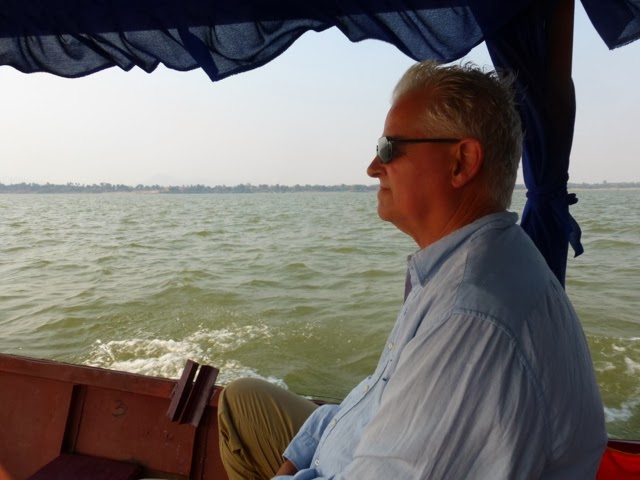Then we were off to Champasak. We took a boat down the very wide Mekong. It was a great way to travel and only two hours so a pleasurable morning jaunt. Our boat.
And our elegant mode of ingress.
Here we look a little more stately.
If we didn't know we were in Laos, we would think we were in France. This large complex is in Paksé but nowhere near where we stayed.
There were fishermen on and along the river.
Hauling nets
Animal life
And small gardens.
And simple houses on stilts.
When we arrived in Champasak we had to ascend these 59 steps.
Champasak is very, very sleepy. Hardly a soul on the street and the town is really all on one street with a few side lanes. We are staying at the newest hotel which is a pink confection. Our room is large, reasonably furnished with air con and a fan for the princely sum of $11.00 a night.
The reason people come to Champasak (I know you wondered) is to visit Wat Phou which is not, as you might think, another Buddhist temple but instead a Khmer archaeological site. The Khmer built Angkor Wat, the very famous temple complex in Cambodia but Wat Phou is actually earlier. The temple is sited on a mountainside below a natural lingam (a phallic symbol) atop the mountain itself. The water here is in a Baray and represents the ocean. The site was begun in the 10th century and the two large water tanks were built here too. That mountain is the phallic one.
The site was originally a Hindu temple. The carved decorations on the temple buildings represent Shiva, one of the gods of the Hindu pantheon. This may not be him.
This stone walkway lined with these stylized lotus buds leads from the tanks up to the second level.
There is a jumble of stone not yet reconstructed.
But there are buildings standing, although their roofs have fallen.
The carved lintels are wonderful.
The area did become a Buddhist site much later. That means there are visiting monks. The trees are frangipani. This long sloping stone way leads up to the steps which take you to the third level which represents heaven.
After this section there are a series of steps, seven in all, each with eleven stairs. Climbing up was hard. So was getting back down. It did seem appropriate to post these pictures today since our friend Marje is exploring similar stepped temples at the same time on the other side of the world in Tikal, Guatemala.
You can see that these are not Buddhist, who are much more modest in dress. We did note that the stones here don't exactly match belly to skirt. I don't know whether the archaeologists have got this one right.
This four headed deity is at an area that looked like a fountain.
Along with this figure too. Somewhat yoga like. 

There is a natural spring seeping from the rocks at the very top of the site. It was channeled into these waterways and water poured constantly over another lingam in the temple complex. The lingam is long gone.
Some distance away is this rock with its carved elephant.
For scale. The red trough contains incense sticks. There are many more just to the right of the young woman's feet.
And a crocodile. The snout is at the lower end.
Last week there was a large full moon religious celebration here. Many people came to watch the ceremonies and to sleep overnight. They left an incredible amount of garbage strewn everywhere. It was terrible to see. But there was a large contingent of people doing their best to clean up, including this young man with his basket for trash.
We were very hot and sweaty after climbing and exploring the site. But it was worth it. We know that Ankhor Wat is very much larger than this and we expect to spend several days exploring it. We are spending another week here in Laos. Tomorrow we head for the 4000 Islands, an area of the Mekong at the bottom tip of the country. We will travel by tuk-tuk, boat, mini-van, boat and tuk-tuk, in that order to get to Don Khong, the first island we'll visit. There are two more, further down, called Don Khet and Don Khon which we may visit too, unless we find ourselves unable to stir because of the heat.





































No comments:
Post a Comment